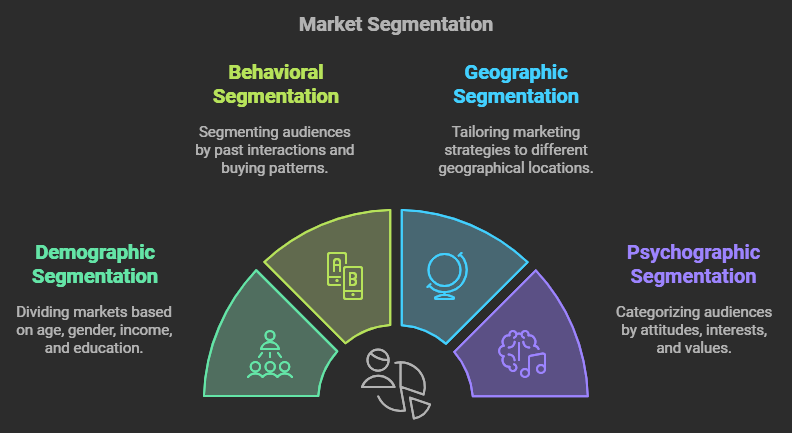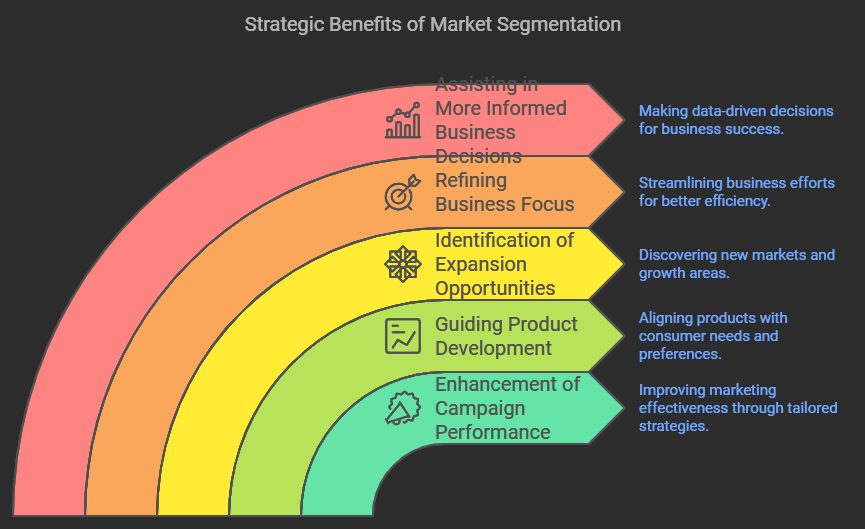What are the 4 types of consumer market segmentation?
Consumer market segmentation is a crucial aspect of effective marketing strategies. It centrally enables businesses to tailor their offerings based on various customer categories’ specific needs and preferences. It involves dividing the overall market into distinct and identifiable groups or segments. This process helps companies understand their target consumers’ unique needs, desires, and preferences comprehensively and nuancedly.
The primary objective is to create custom-tailored products and services that precisely align with the expectations and needs of the specific customer segments. Four critical types of consumer market segmentation—demographic, psychographic, geographic, and behavioral—each provide vital insights into consumer behavior and help to mold a more efficient, targeted, and personalized marketing approach.
The Role of Market Segmentation
Market segmentation primarily entails classifying potential buyers into distinct groups based on shared attributes or characteristics. The primary purpose of doing this is to help companies gain more in-depth insight into the behaviors, attitudes, and influencing factors that may impact the purchasing decisions of their actual and potential customers.
Market segmentation offers numerous benefits, including the optimal allocation of marketing resources, improved conversion rates, valuable input for developing and enhancing products or services, identifying and exploring potential new markets, and facilitating personalized communication with each market segment.
In the modern era of data-driven, precision marketing, customized communication is pivotal in consumer engagement. By customizing and optimizing their marketing strategies based on consumers’ common traits or characteristics, businesses are better positioned to attract, engage, and retain their target audience. A segmentation-based approach is instrumental in making this possible.
It paves the way for hyper-targeted emails or ads to reach the most relevant demographics, segregate the leads into different sales cycle stages, and shape campaigns that align with individual market segments’ specific needs and preferences.
Unveiling the Four Types of Market Segmentation

Delving into Demographic Segmentation
Demographic segmentation involves dividing the consumer market into separate groups based on specific traits such as age, education level, gender, occupation, family status, and income level. Companies can enhance the likelihood of engagement and conversion by customizing and optimizing their marketing campaigns to appeal to these varied groups.
For example, a clothing retailer could use demographic segmentation to target trendy, modern styles for younger consumers and professional, business-oriented attire for older professionals. This segmentation approach empowers businesses to craft highly effective marketing strategies by offering a deeper understanding of their target audience and their preferences.
Understanding Behavioral Segmentation
Behavioral segmentation is essentially the division of your target audience based on their past interactions with your brand, their knowledge about your products, their buying patterns, their familiarity with your business, and their overall rating or perception of your products. Analyzing these behaviors enables a business to understand better and formulate effective marketing strategies for each audience segment.
For example, if behavior analysis reveals that a specific audience segment responds favorably to email marketing, then the focus should be on enhancing email outreach for that demographic. This can significantly increase engagement and conversion rates. Behavioral segmentation is instrumental in optimizing marketing efforts, leading to higher customer retention and loyalty.
An Overview of Geographic Segmentation
Geographic segmentation involves dividing the audience based on their geographical locations. This segmentation methodology may prove beneficial for companies intending to customize and optimize their marketing campaigns based on their target consumers’ specific needs and preferences in different geographical locations. A clothing company, for example, could promote its winter clothing line in colder regions and summer clothing in warmer areas.
This location-based strategy enables companies to run perfectly personalized and effective marketing campaigns targeted at the ideal demographics in each location.
The Aspects of Psychographic Segmentation
Psychographic segmentation involves categorizing the audience based on their attitudes, interests, lifestyle, values, and personalities. By understanding these intricate aspects, businesses can curate tailored marketing campaigns that resonate with specific consumer groups. Imagine a clothing brand targeting customers passionate about sustainability and eco-conscious materials.
Although psychographic segmentation may pose certain challenges, it can be gratifying if implemented effectively. It facilitates an in-depth understanding of the driving factors behind consumer behavior, enabling businesses to cater mindfully and strategically to their target audience’s unique wants and needs.
The Advantages of Market Segmentation

Enhancement of Campaign Performance
Market segmentation can significantly enhance marketing campaigns’ performance by facilitating resource allocation efficiency and tailored messaging’s effectiveness. By dissecting and understanding consumer segments and molding messages to align with their unique behaviors and preferences, there is a higher likelihood of engagement with the content or advertisements. This, in turn, translates into improved overall return on investment (ROI).
Advanced tools such as customer relationship management (CRM) software like Commence CRM can further optimize campaign performance by providing crucial insights into consumer behavior, thereby driving strategic decision-making.
Guiding Product Development
Market segmentation plays a vital role in product development by illuminating each consumer demographic’s specific wants, needs, and preferences. Insights derived from behavioral segmentation can reveal past buying trends and patterns, while geographic segmentation can provide valuable information about location-based needs and preferences.
Companies can leverage these insights to customize their product offerings in alignment with the derived consumer insights, effectively increasing the success rate in the market.
Identification of Expansion Opportunities
Market segmentation can assist in identifying lucrative and viable opportunities for business expansion within existing and potential customer bases. By thoroughly analyzing the different consumer segments, companies can uncover specific needs or wants that can be satisfied through targeted marketing efforts. Using geographic segmentation, for instance, businesses might identify regions where their product or services could meet an unfulfilled market need.
This could present an opportunity for business expansion and further increase their reach and presence in new markets.
Refining Business Focus
Market segmentation allows companies to fine-tune and prioritize their focus to target strategic business areas. Segregating potential consumers into distinct categories refines marketing efforts, catering to each group’s specific desires and needs, resulting in increased efficiency. This tactic paves the path to creating tailored marketing campaigns, leading to enhanced marketing efficacy and a subsequent rise in customer loyalty.
Assisting in More Informed Business Decisions
Market segmentation is crucial in enabling more informed and strategic business decisions. With a comprehensive understanding of the target audience, businesses can enhance the efficiency of their marketing campaigns and improve returns on investment by delivering highly personalized and relevant messaging. It provides critical insights for strategic decision-making around pricing, distribution, and other essential areas of business operations.
Market segmentation allows companies to meet and exceed evolving customer expectations and enhance satisfaction levels, paving the way for continued business success.
The Art of Market Segmentation

Market segmentation is an art that involves the careful subdivision of audiences based on shared attributes or characteristics. It can be accomplished through demographic segmentation, which focuses on visible differences like age and gender, geographic segmentation, which targets location-based variables, psychographic segmentation, which takes into account lifestyle choices and preferences, and behavioral segmentation that evaluates interactions with a brand and its products or services.
A well-implemented market segmentation strategy can significantly enhance marketing performance, inform vital business decisions, and provide a competitive edge. Advanced tools such as Spherical powered by Lotame maximize the value of your first-party data and provide meaningful insights into customer behavior and preferences, making market segmentation a more valuable and manageable endeavor.

Vizologi is a revolutionary AI-generated business strategy tool that offers its users access to advanced features to create and refine start-up ideas quickly.
It generates limitless business ideas, gains insights on markets and competitors, and automates business plan creation.


